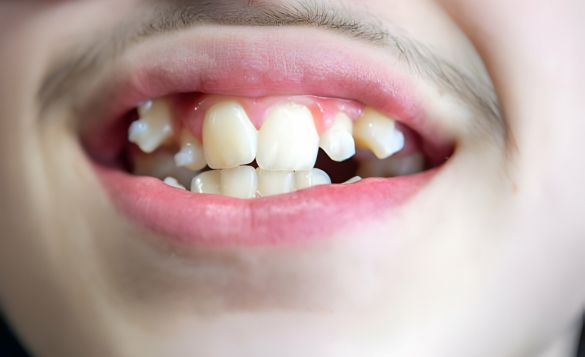
Archives
Categories


An ankylosed tooth is a dental condition where the root of a tooth fuses with the surrounding bone, causing it to become immobile. This fusion can occur due to various factors, including trauma, infection, or genetics. When an ankylosed tooth occurs, it loses its ability to move and function properly within the dental arch. It can affect both primary (baby) teeth and permanent teeth.
Ankylosis can occur at any age, but it is more commonly seen in children. In some cases, ankylosed teeth may go unnoticed, while in others, they can cause significant discomfort and dental issues. Understanding the causes, symptoms, and treatment options for an ankylosed tooth is essential for optimal oral health.
Ankylosed teeth can present unique challenges, but with appropriate intervention, the condition can be managed effectively. Let’s explore the causes, symptoms, and complications associated with ankylosed teeth in more detail.

Ankylosed teeth, a condition where a tooth fuses to the surrounding bone, can arise from various factors. Trauma, such as a forceful impact on the mouth, can damage the tooth’s root, leading to fusion with the bone. This fusion can result in localized pain, swelling, and discomfort, particularly when pressure is applied during chewing or speaking. Additionally, ankylosed teeth may cause difficulty in chewing or speaking, impacting normal mouth functions. Over time, misaligned teeth may develop as the ankylosed tooth disrupts the natural alignment of surrounding teeth. This misalignment can lead to issues like crowding, spacing irregularities, or bite problems. Recognizing the signs of ankylosed teeth is crucial for prompt diagnosis and treatment to address discomfort and prevent further dental complications.
If left untreated, an ankylosed tooth can lead to various complications, including:
Misalignment of other teeth: Ankylosed teeth can disrupt the natural alignment of neighboring teeth. The immobile tooth may create spaces or cause crowding, which can affect the overall aesthetics and functionality of the smile.
Jaw problems: Ankylosed teeth can also impact the proper development and growth of the jawbone. This can result in bite problems, temporomandibular joint (TMJ) disorders, and difficulties with oral functions such as chewing and speaking.
Tooth decay and gum disease: Ankylosed teeth can be more prone to dental issues such as tooth decay and gum disease. The fusion of the tooth with the bone can create challenges when it comes to maintaining proper oral hygiene, making the tooth more susceptible to bacterial buildup.
Understanding the potential complications of ankylosed teeth underscores the importance of early diagnosis and appropriate treatment. Dental professionals can provide personalized guidance and treatment options to address these concerns effectively.
Diagnosing an ankylosed tooth typically involves a comprehensive dental examination and may include additional diagnostic tools, such as X-rays or 3D imaging. The dental professional will assess the tooth’s mobility, evaluate the surrounding tissues, and look for signs of fusion between the tooth root and the bone.
In some cases, a periodontal probe or other specialized instruments may be used to assess the tooth’s stability and measure the depth of the fusion. The dental professional will also consider the patient’s dental history, symptoms, and any underlying factors that may contribute to ankylosis.
Accurate diagnosis is crucial for determining the most appropriate treatment plan. Therefore, it is essential to consult with a qualified dental professional if you suspect you have an ankylosed tooth.

The treatment approach for ankylosed teeth depends on various factors, including the severity of the condition, the age of the patient, and the tooth’s location within the dental arch. The goal of treatment is to preserve oral health, restore functionality, and maintain proper aesthetics.
Here are some common treatment options for ankylosed teeth:
Orthodontic procedures: In mild cases, orthodontic interventions such as braces or aligners may be sufficient to realign the affected tooth and improve its functionality. Orthodontic treatment can help create space for the ankylosed tooth to move and reduce the risk of further complications.
Dental restoration: Dental restorations, such as crowns or veneers, can be used to improve the appearance and functionality of an ankylosed tooth. These restorations can also help protect the tooth from further damage and prevent surrounding teeth from shifting.
Tooth extraction: In severe cases where the ankylosed tooth cannot be salvaged, tooth extraction may be necessary. Extraction may be followed by orthodontic treatment or dental implants to restore the missing tooth and maintain proper oral function.
Infection: Severe dental infections, such as periodontitis or abscesses, can also contribute to ankylosed teeth. Infection can damage the tooth’s supporting structures, resulting in fusion with the bone.
Genetic factors: Some individuals may be more prone to ankylosed teeth due to genetic predispositions. Certain inherited conditions can affect the development and eruption of teeth, increasing the risk of ankylosis.
Recognizing the symptoms of ankylosed teeth, such as noticeable signs like abnormal tooth positioning or lack of normal tooth mobility, is crucial for early intervention. Consulting a dental professional is key to determining the most suitable treatment option based on individual factors. While some causes of ankylosed teeth, like trauma or genetics, may not be preventable, adopting preventive measures can help mitigate the risk or severity of ankylosis. Strategies such as maintaining good oral hygiene through regular brushing, flossing, and dental check-ups are fundamental in preventing dental infections that could lead to ankylosis. Additionally, wearing protective gear,
such as mouthguards during physical activities prone to dental trauma, can reduce the likelihood of tooth damage. Seeking timely dental care after any dental trauma or unusual symptoms is vital, as early intervention can avert complications and enhance treatment outcomes.

Caring for ankylosed teeth demands a meticulous approach to oral health to prevent complications. Essential practices include brushing twice daily with a soft-bristled toothbrush and fluoride toothpaste, daily flossing, and using antimicrobial mouthwash to combat plaque and reduce the risk of decay and gum disease. Regular dental check-ups are vital for monitoring oral health and addressing emerging issues promptly. Collaborating with dental professionals to develop a personalized oral care routine is crucial. This customized plan may involve specific tools or techniques tailored to individual needs. Dietary choices play a role in maintaining oral health; avoiding hard or sticky foods can prevent strain on ankylosed teeth. Opting for a balanced diet that supports overall oral health is beneficial. By following these guidelines, individuals with ankylosed teeth can promote oral health and prevent further complications effectively.
Ankylosed teeth are more commonly observed in children, especially when primary teeth are affected. The impact of ankylosis on primary teeth can have long-term consequences for the child’s dental development.
If an ankylosed primary tooth is left untreated, it can lead to issues such as delayed eruption of permanent teeth, crowding, or misalignment. Prompt diagnosis and appropriate intervention are crucial to prevent these complications.
Treatment options for ankylosed primary teeth may include monitoring the tooth’s eruption, orthodontic interventions, or extraction if necessary. Dental professionals with expertise in pediatric dentistry can provide specialized care and guidance for children with ankylosed teeth.
Ankylosed teeth can cause discomfort and pose challenges to oral health. Understanding the causes, symptoms, and treatment options for ankylosed teeth is essential for timely intervention and optimal outcomes.
If you suspect you have an ankylosed tooth, it is crucial to consult with a dental professional. They can accurately diagnose the condition and recommend the most suitable treatment plan for you. Remember, early detection and proper treatment are key to preserving your oral health. With the right care and intervention, ankylosed teeth can be effectively managed, ensuring a healthy and functional smile.
Ankylosed teeth may need to be removed if they are causing functional or aesthetic issues, impeding dental development, or leading to complications like bite problems.
Ankylosis of a tooth occurs when the tooth fuses with the underlying bone, inhibiting its normal movement within the jaw. This condition can affect both primary and permanent teeth.
The most common tooth affected by ankylosis is the primary mandibular second molar, followed by the primary maxillary second molar.
Ankylosis of primary teeth can be caused by various factors, including trauma, genetics, systemic conditions, or developmental abnormalities affecting the tooth’s attachment to the bone.
Our website uses cookies to improve your experience. Learn more about: Cookie Policy
Leave a Reply